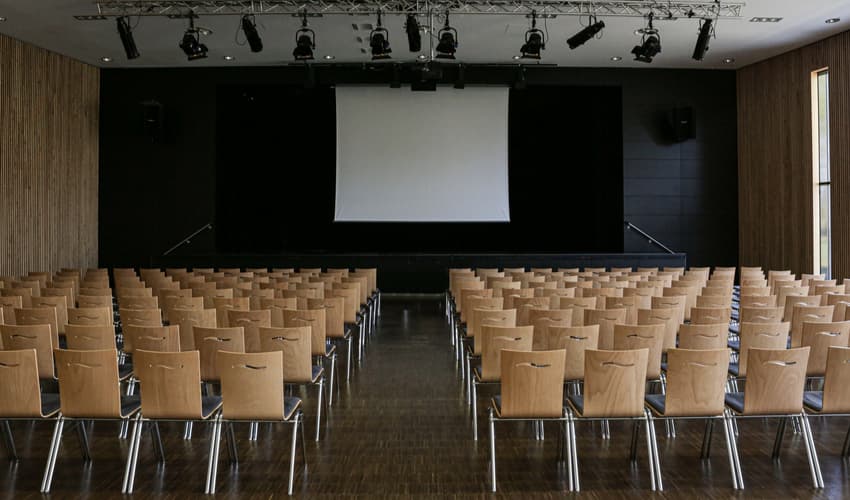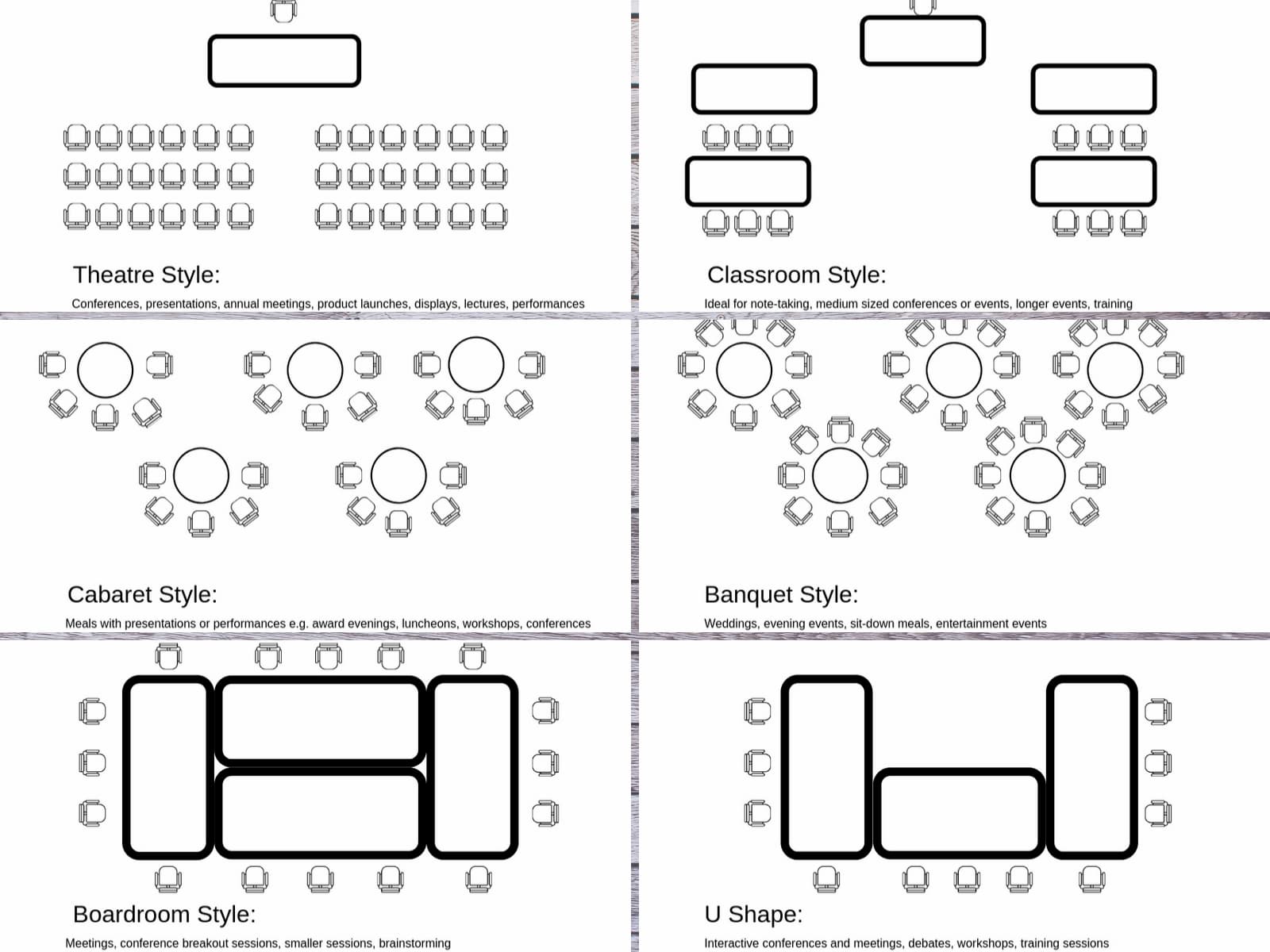One of the most important aspects of any event is the proper layout of the seating to meet the needs of the clients.
An important factor is the weight of the banqueting tables and chairs. Steel banqueting chairs are heavier than aluminium chairs. This increases the risk for the staff members responsible for manoeuvring, carrying and stacking the chairs. When the weight of the chairs is too heavy, they can become a staff hazard as well as a potential safety and health risk for the handlers.
Storage trolleys enable the staff to move the event tables and banquet chairs quickly and easily. This decreases the number of staff and time required to set up the event. The wheels of the storage trolley must be wide enough to easily roll across the carpet pile without causing any damage to the floor covering. One of the more luxurious and costly options are aluminium banquet chairs, while not stacking as high (four to six chairs) they do offer flexibility and efficiency during layout.
The seating arrangements and the layout of the room is an important consideration. The type of layout can improve the overall event with a maximum number of individuals for each type of layout. The best level of comfort is ten to fifteen percent less than the maximum number of guests allowed for the layout. The layout and the actual number of attendees must be determined prior to choosing the layout.

The Different Styles of Event Seating
Some of the most popular styles of event seating are:
Theatre Seating: This is when there are rows of chairs placed facing the front of the room, a central point or a stage. This is an excellent option when there are a large number of guests requiring seats. Theatre seating is popular for conferences, formal presentations or events with numerous speakers. This type of seating is not recommended for attendee interaction.
Family-Style Seating: Family-style seating offers one long table or several rows of lengthier tables. Long banquet tables are absolutely stunning where there is enough space. This trendy style of seating provides an intimate atmosphere and allows for incredible photographs even when the event is extremely large. Family-style seating is popular for informal events, banquets and wedding receptions.
Classroom Seating: Classroom seating has a similar layout to theatre seating. The difference is there are tables for each row. This enables the guests to take notes comfortably, enjoy the refreshments and work on a computer. Classroom seating is generally used for interactive seminars, workshops and training courses.
Auditorium Seating: Chairs are lined up in rows to face a projector, podium or stage. This is a good option for audience-style events. Auditorium seating is not recommended when food is available or for taking notes. This type of seating is popular for product launches, performances and lectures.
Banquet Seating: Round tables are set up in groups to seat the attendees. All of the guests will be facing towards the centre. Depending on the size of the tables, there are generally eight to fourteen individuals at each table. Banquet seating is mainly used for formal lunches and dinners or events requiring a seating plan. This layout will restrict the comfort of the attendees if they are required to turn for extended periods of time to face a central point or a speaker.
Conference Seating: This provides an oval or single table able to seat a maximum of 25 guests. This is ideal for small meetings where the priority is brainstorming and discussions. Conference seating is popular for seminars and meetings.
Cabaret Seating: Cabret seating has a similar layout to banquet seating. The difference is the end is left open to so the guests are facing forward. This provides a clear line of sight for a presentation area or a speaker. This is a good option for an interactive and less formal environment. Cabaret seating is popular for training events, breakout sessions, conferences, workshops and awards shows. The most restrictive layout for the guests is cabaret seating.
If there is any uncertainty as to the final number of attendees, a cabaret layout should be requested for the maximum number of potential guests. This will ensure both the room and the venue are able to accommodate the entire group.
Hollow Square Style Seating: This is an arrangement of rectangular tables placed in a square. This is appropriate for smaller groups with a maximum of thirty attendees with a speaker at one end or in the centre. Hollow square style seating is popular for workshops, training sessions and small meetings.
U Shape Seating: The chairs and tables are placed in a shape similar to the letter U. One end is open to accommodate the speaker with the attendees facing inwards. This is popular for small to medium-sized groups, presentations and meetings. The U shape enables the speaker to interact with all of the guests while moving around freely.
Cocktail Style Seating: This venue is standing space only with no tables or chairs. This style uses floor space extremely efficiently. The guests can move around and mingle easily. Small bites and finger foods are served as opposed to a sit-down lunch or dinner. Cocktail style seating is popular for shorter events, social events, drinks receptions, business mixers, networking sessions, Christmas parties and cocktail parties.
Boardroom Seating: This venue uses a large table, usually oval or rectangular in shape. All of the guests sit around the table and face inwards. Venues usually have a few smaller rooms with luxurious furnishings and a fixed boardroom layout to maximise the comfort of the guests. Boardroom seating is popular for dinners, high profile meetings and breakout sessions.
Assigned Seating: Seating charts are highly recommended if the guest list exceeds fifty people. This helps decrease any potential conflicts and confusion among the attendees. The majority of individuals prefer assigned seating because they are more comfortable knowing they do not have to look for somewhere to sit. If the event includes a meal, the catering staff use the seating chart to ensure all of the guests receive the correct meal. This eliminates any potential mix-ups.

The seating plan needs to be made after all of the RSVPs have been received as opposed to before. If the attendees will only be sitting down for short periods of time, it does not matter which guest sits where. Everyone will have the opportunity to mingle both before and after they are seated.
There are a lot of different layouts and layout combinations available. The above layouts are simply some of the more popular options. Prior to reserving a room and a venue, it is important to know the best way to use the space for the event. Everything must be within reason while following any restrictions of the venue. The combination of AV and creative production can transform a room completely for a wide variety of themed environments. The production teams should be involved early for the selection process for this type of event.
Related Articles
- Banqueting Tables Buying Guide
- Banqueting Chairs Buying Guide
- Guide to Crowd Control Barriers for Events, Exhibitions, Festivals
- Banqueting Chairs Bulk Buy Discounts
- Event Planning Guide – Event Design and Event Layouts